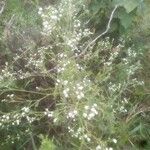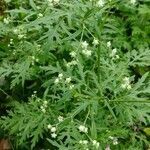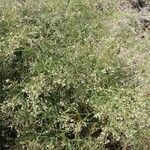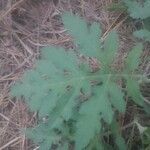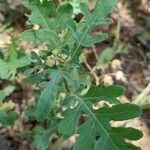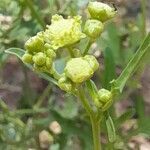Erect taprooted annual, (0.2–) 0.3–1.75 (–2.0) m high, mostly single-stemmed and much branched above; stems and leaves pubescent and glandular-punctate or resin-dotted. Leaves bipinnatisect; lower leaves 4–13 (–20) cm long, 3–4 (–7) cm wide; upper leaves less divided and smaller. Capitula in terminal panicles, 3–5 mm diam., white. Outer involucral bracts ovate, 1.5–2.0 mm long, pilose; inner involucral bracts circular, 2.0–2.2 mm long, pilose on margin. Ray florets with ligules 0.5–0.7 mm long, broad, truncate to emarginate. Disc florets cream. Achenes 1.7–2.0 mm long, plano-convex, black; apex and centre of each face densely white-papillose. Pappus of 2 broad membranous scales, c. 0.5 mm long, white.
Annuals, (10–)30–120+ cm. Leaf blades ovate to elliptic, 30–180+ × 10–50(–90+) mm, (1–)2-pinnately lobed (ultimate lobes lanceolate to linear, 3–50 × 2–15 mm), faces sparsely to densely scabrellous and gland-dotted (seldom with additional erect hairs 1–2 mm). Heads obscurely radiate, borne in open, paniculiform arrays. Peduncles 1–8(–15+) mm. Phyllaries: outer 5(–6), lance-elliptic, 2–4 mm, inner 5(–6) ovate to ± orbiculate, 2.5–4 mm. Pistillate florets 5(–6); corolla laminae reniform or orbiculate to oblong, 0.3–1 mm. Disc florets 12–30[–60]. Cypselae obovoid, 1.5–2(–3.5) mm; pappus-like enations erect, deltate to ovate, 0.5–1 mm (sometimes a third, subulate spur near apex adaxially). 2n = 34.
Herbs, annual, 30-120 cm tall. Leaf blade ovate to elliptic, 3-18 × 1-5(-9) cm, pinnately (1 or)2-lobed, ultimate lobes lanceolate to linear, 3-50 × 2-15 mm, both surfaces sparsely to densely scaberulose and gland-dotted. Synflorescences of open panicles. Capitula obscurely radiate; peduncles 1-8(-15+) mm; outer phyllaries 5(or 6), elliptic-lanceolate, 2-4 mm, inner 5(or 6) ovate to orbicular, 2.5-4 mm. Female florets 5(or 6); corolla limbs reniform or orbicular to oblong, 0.3-1 mm. Disk florets 12-30(-60). Achenes obovoid, 1.5-2(-3.5) mm; pappuslike enations erect, deltate to ovate, 0.5-1 mm. Fl. Apr-Aug. 2n = 34.
Annual herb to 60 cm high; stems puberulous or scabridulous.. Leaves elliptic to ovate, bipinnately lobed, 6–30 cm long, 3–10 cm wide, lobes 1.5–4 mm wide and obtuse, puberulous on both surfaces.. Capitula hemispherical, in lax panicles; involucre 2–3 mm long, the phyllaries pubescent.. Ray florets 5, whitish, almost round, 0.5–1 mm; disc florets yellowish, narrowly funnel-shaped, ± 2.7 mm long.. Achenes black, obovoid, ± 2 mm long, with 2 recurved pappus awns.. Fig. 177 (page 816).
Annual herb to 60 cm high; stems puberulous or scabridulous. Leaves elliptic to ovate, bipinnately lobed, 6-30 cm long, 3-10 cm wide, lobes 1.5-4.0 mm wide and obtuse, puberulous on both surfaces. Capitula hemispherical, in lax panicles; involucre 2-3 mm long, the phyllaries pubescent. Ray florets 5, whitish, almost round, 0.5-1.0 mm; disc florets yellowish, narrowly funnel-shaped, ±2.7 mm long. Achenes black, obovoid, ±2 mm long, with 2 recurved pappus awns.
Annual to 1 m, usually much branched, ± hairy, and often glandular above; lvs pinnatifid or usually bipinnatifid, to 2 × 1 dm; heads small, numerous in an often leafy infl, the disk 3–5 mm wide; achenes obovate, black, 2–2.5 mm; 2n=34. A weed of waste places; trop. Amer., n. to se. U.S. and occasionally to Mass., Mich., and Kans. July–Oct.
Annual herb, up to 0.6 m high. Leaves deeply bipinnatisect, puberulous, decreasing in size upwards. Heads 3 mm in diameter, on slender peduncles, in lax, many-headed panicle. Flowers with (small) white rays and yellowish disc.
